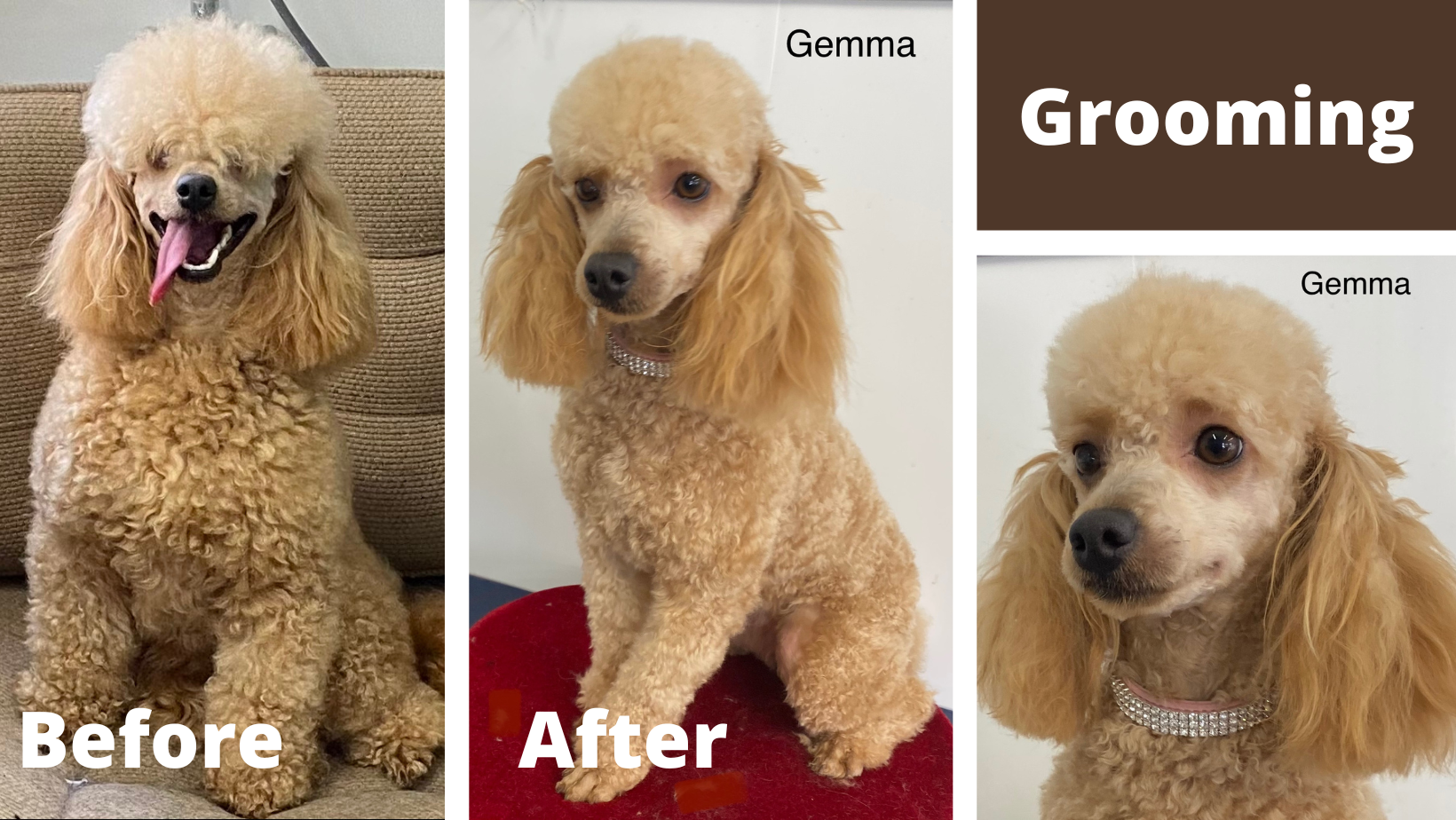 Grooming
GroomingInformation from Diplomat Standard Poodles (Thank You, Tempest Deptuch)
There are many different ways to groom your poodle. There is the show trims and the pet trims. Only three trims are allowed in the conformation show ring but you can have them trimmed almost anyway for obedience, (the exceptions being some specialty obedience shows). Although as a breeder I have a great appreciation for the show trim it looks rather unusual to most people. The show trim does have a history in the breed. Standard Poodle were originally bred as water retrievers. The long "lion mane" was designed to keep the dogs vital organs warm when they swam in cold water. The puffs on the feet were to keep the joints warm, the puff on the tail so you could see the dog while it was swimming in the water. The rest was shaved to keep him from getting water logged and to prevent sticks from catching in the hair.
Types of Clips
Show Clips
There are only three clips that are acceptable for the show ring.
Puppy Clip
The first of these is the Puppy Clip. A Poodle under a year of age may be shown in the Puppy Clip with the coat long except for the face, feet and base of tail, which are shaved. Scissoring is allowed to even up the hair and remove any straggly hairs. Dogs one year old or older must be shown in either the English Saddle Clip or Continental Clip. The Continental is the most popular show trim for standards as it is designed to show off their good hindquarters.
Continental Clip
In the Continental Clip the hindquarters are shaved with pompons on hips, these are optional but it is unusual to see the trim without them. The face, feet, legs and tail are shaved leaving bracelets on the hindlegs, puffs on the forelegs and a pompon at the end of the tail. The rest of the body must be left in full coat.
English Saddle Clip
In the English Saddle Clip the hindquarters are covered with a short blanket of hair except for a curved area on the flank and two shaved bands on each hind leg. The face, forelegs and tail are shaved, leaving puffs on the forelegs and a pompon at the end of the tail. The rest of the body must be left in full coat.
Kennel or Sporting Clip
One of the most popular of the trims not allowed in the show ring is the Kennel or Sporting clip. This clip is similar to the Puppy Clip but the coat is clipped closer to the neck and body and the legs are left less full. The shorter coat requires less brushing, and looks great on all poodles. I have always wished that we could show them in this trim as many great dogs are never shown because there is so much care required to keep the hair in show condition. It is also almost impossible for the average person to maintain and trim a dog for show.
Dutch Clip
Another trim for pets is the Dutch Clip. The head is clipped, sometimes leaving a mustache on the end of the nose, and the ears are clipped, leaving only a fringe at the bottom. The topknot is rounded off. The chest, stomach and back of the dog are clipped, leaving the long hair on all four legs either squared off above the shoulders or coming to a point higher up. Feet and tail are clipped.
Clipping Your Own Dog
General hints regarding clipping:
Make sure you have good quality clippers and scissors.
Never force the clippers or use dull blades, because you can scrape the skin and cause clipper burn.
Poodles with whites, grays and browns, have more sensitive skins than do the blacks, and that a dog that is regularly clipped does not scrape as easily as one left unclipped for a long while.
Sores made by scraping can get infected very easily and at times need to be treated with an antibiotic or fungicide. I recommend the No. 10 or a No. 15 Oster Clipper blade for puppies or dogs that are not trimmed regularly or the have sensitive skin.
A No. 30 or higher is normally only used in show trims and should not be used by inexperienced groomer as they can burn the skin.
Most grooming equipment can be picked up at a good pet store or at a dog show. Some groomers will order professional type of equipment for you.
Ask for their help if you are not sure what to get. (I do not buy anything from stores that sell puppies or kittens, but this is a personal chose).
Clipper and Blades
Good clippers are costly and should be cared for, they will last longer and the blades will stay sharper.
A good set of Oster clippers cost about $175 and blades anywhere from $25 to $40. Never use clippers on a very dirty dog or you will have to sharpen the blades.
Clippers must be oiled and greased inside regularly. They will break if you drop them and it always seems that they get kicked off the table by a dog so never leave them on the table.
It is convenient to have a number of blades for your clippers. They can be changed in the midst of clipping if they get too hot, and whatever size blade you choose to use is always ready.
The blades should be changed rather often, since a dull blade pulls the hair and tends to leave the coat ragged. The small carbon brushes and springs wear out quickly in an old clipper, making the machine rattle when it is run; as they are easily replaced by unscrewing the small knobs on the side of the machine, these extra parts should be always on hand.
Scissors
A good pair of scissors cost $50 to $75 and should be chosen carefully. I prefer "double ducks" with a 7 inch blade.
There are many on the market so test them out and see how they fit your hand, all scissors have a difference feel.
Brushes and Combs
I use different brushes and combs depending on whether the dog is in a show clip or a pet trim.
For a show clip I only use a wooden handled bush with long flexible steel pins (some call these wig brushes). I use an English comb called a "greyhound" this is a steel comb with long fine teeth.
Everyone has a preference and it depends on what you are used to. For my pets I normally use a "cocker" slicker brush. They are silver with a red handle. I find they don't scratch the skin like some slicker brushes do.
I never use a slicker brush on a show coat; it tends to split the ends of the hair. Any good steel comb will work on pet trims.
It is important to brush out all the mats and tangles before you bath the dog, as they will only get worse once they are wet. Bathing tends to tighten up the knots.
I use the guillotine type of nail clipper but they all seem to work well. The most important thing when trimming nails is to not get them to short.
Take off a little once a week. If you do plan on grooming your own dog regularly have some "quick stop" on hand to use in case you nick the dogs quick (you can purchase this at most pet stores). The quick is a small blood vessel running through the nail.
If you trim the nails often the quick will recede. Clipping the nail to short and hitting the quick is not life threatening to the dog but it will make it harder to do his nails the next time. It is painful for them if you cut into the quick and should be avoided.
Bathing
Bathing your dog can either be a nightmare or a pleasant experience for both of you depending on how you go about it.
I have a raised bathtub (it's easier on the back) with a non-slip floor. It is necessary to have a long shower hose with good water pressure.
The biggest mistake most home groomers make is not getting out all the shampoo. It really makes not difference what shampoo you use, but you have to make sure you rinse them really well. Leaving soap in the hair will dry out and irritate the skin; this is why a lot of them tend to scratch (assuming they don't have fleas).
Speaking of fleas, regular shampoo will not kill them or the eggs. You must use a shampoo specifically for ticks and fleas.
Read the labels, some will kill only the fleas on the dog and some will kill the eggs and adult fleas as well as one that jump on later.
I use a light cream rinse on the dog when I bath because it makes the coat easier to brush later.
When you towel dry the dog don't rub the coat against the grain this will encourage knots. Just squeeze the coat with good absorbent towels.
I bath my dogs every two to three weeks, more often if they get dirty.
I use a stand up commercial dryer for my dogs but they are very costly, ($400 and up).
For pets a good hand dryer will work just fine. If the weather is warm you can partly air dry them and just use the hand dryer to fluff them up at the end.
If you do use a commercial cage dryer make sure that the animal does not get to hot especially if they are older, they can get heat prostration even from a dryer.
Some poodles tend to have ear problems for a number of reasons.
They have heavy leathers and not much air gets in, making it a perfect environment for breeding bacteria.
It seems that once you have ear problems they are very hard to clear up, they seem to re-occur. Poodles also tend to grow hair in their ears again keeping them from "breathing". I will tell you what I do with my dogs but it may not work for all.
I clean their ears every time I groom or once every two weeks. I remove "pluck" any hair I can reach in the ear canal with my fingers.
I wipe them out with a light mixture of vinegar and water (very diluted as the vinegar will burn) making sure that the ear is dry when I'm done.
If you think they are damp inside (after bathing this could happen) use a hand dryer to dry them out. (Wet ears grow bacteria easier then dry ears). I tend not to dig at them with q-tips if possible; this will drive the wax further into the ear canal.
I find that the more you dig at the ear the more infections you cause. If the dog does have an ear problem talk to your vet about the best way to treat it.
Never let the ears get really bad, as I have heard of dogs rupture their eardrums by excessive head shaking because of bad ears.
Grooming is one of the biggest expenses in owning a poodle.
If you can afford it and don't like dog hair in your house or bathtub have them groomed by a professional shop.
Pick your groomer as carefully as you would pick your hairdresser. If the cost of regular grooming is to costly for you, have a groomer do it every second time, this will save you a bit of money.
If you want to do all your own grooming get a good book and some help from other who do it themselves. I prefer to see a poodle cut right down then to see them unkempt, matted and dirty.Keeping them clipped very short is a necessity for dog that live on farms, bushy area, or if they are use for hunting.
Good Grooming Books and Videos
The Complete Poodle Clipping & Grooming Book (by Kalstone) $35
The Poodle (Oster video 30 min.) $47
If you can't find these books in your local area they can be ordered from:
Dogs in Canada
89 Skyway Avenue, Suite 200,
Etobicoke, Ontario
Canada M9W 6R4
Phone (416) 675-5511 EST
Fax (416) 675-6505
Attn. Book Dept.
Poodles
Poodles were originally bred for hunting and water retrieving, in the large size. This variety is called STANDARD - above 15".
The next size of poodle would be the MINIATURE - above 10 - 15".
The last size is the TOY - up to 10".
There are three varieties according to size, they are the same breed. Registered dogs are not necessarily show dogs.
The Parti-Poodle is two distinct colors at the skin.
The Phantom-Poodle is lighter in color at face, feet, and tail.
This color has similarities to Siamese Cat markings. These two types are not desirable by A.K.C. standards.
The correct poodle body should be exactly square, breastbone to tail base equals withers to ground. The coat texture should be dense and wiry.
Puppy coat refers to the immature coat of any breed. Usually this coat is limp and fine, the change may occur anytime from 8 to 12 months.
The Poodle coat gives the professional groomer a chance to be creative. This is definitely an art form. Poodles may be clipped in a variety of patterns.
These patterns range from casual to formal to the absurd.
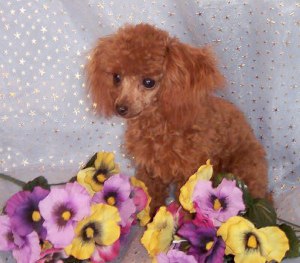 .
. 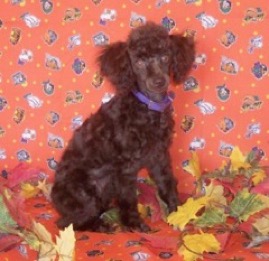 .
. 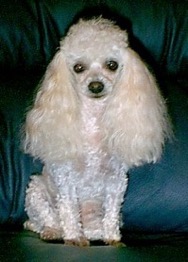
Clips
by. Connie Hershberger
Within the past 10 to 15 years, the methods for styling poodles has evolved dramatically. It is now perfectly acceptable, even encouraged, to trim poodles with style and flair. Contour grooming, which was not well known, has gained popularity because it allows the groomer to interject his or her own style and personality into the grooming process. Before you begin grooming, decide which trim is the most appropriate for the poodle you have before you. It has always helped me to imagine my scissors as a pencil, and myself an artist sketching a picture or sculptor molding in a piece of clay. Balance and proportion are the keys to enhancing each basic pattern trim.
Kennel
The body and legs are clipped evenly and the face, feet and tail are specified.
Use any length blade on the body and legs, and leave pompons of equal size on the head and tail. The hair on the ears also may be shortened proportionately based upon request.
This is a general cut that can be applied to any breed cross or mix.
The head, body, legs, face, feet and tail are clipped evenly all over. Many times this is done to remove matting.
This is a general cut that can be used on any breed, cross or mix pet.
Lamb
The body has a short pattern with the legs longer and fluffy. It is blended where pattern and longer hair meet.
This blending is scissored so you can not tell the difference where the shaved pattern started and stopped.
The legs are scissored, tapering slightly towards the foot. The face, feet and tail are specified. Use a #1, #1 1/2, and a #4 or #5 or #7 blade on the body.
Blending from the bladed area, scissor in the legs and the chest area. The front legs should appear as columns and the rear legs should show angulations.
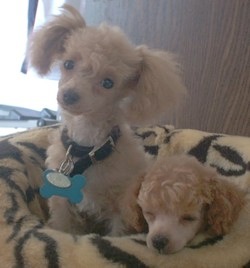
Clown
The body is clipped going partially down the legs.
Bracelets are placed on all four legs.
The rear bracelet is placed first by clipping just above point of hock and ending at the ankle.
This is according to size of the dog. The front of the bracelet should be placed in front of the joint bend.
The foreleg bracelet is placed to line up with rear bracelet.
All should be scissored to be the same size, with definition of shaved leg and bracelet.
The entire body and legs are hand scissored.
The face, feet, genital area and tail are specified using a #15 or # 10 blade.
The topknot has no definition of the ears and neck. It is an exaggerated or full neck.
This may be modified for pet if it is collared at all times. The front legs should appear as columns and the rear legs should show angulations.
This is the required clip for any Poodle that is shown up to 1 year old. At 1 year and up, the Continental or English Saddle is required.
Shaved pattern on body resembling a cross as viewed from above.
The stripes are placed on spine and waistband. Use a # 5/8, # 7/8 or # 8/8 blade on the band, depending on the size of your dog.
The band should start at or just behind the last rib. Balance and contour as you scissor the remainder of the coat.
Be sure the top line is level. The spine line is placed from withers to base of tail.
The edges of the cross pattern are slightly rounded to give appearance of diamond on back.
The waistband and spine or back line are of equal width. The width of lines will depend on the size of the dog.
A good judge for this is the width of tail just above the base. Use a # 15 or # 10 blade on the neck area.
The neck band should end where the neck meets the shoulder.
Royal Dutch
This is the same as the Dutch pattern with the exception of the waistband.
The waistband is twice the width of the spine line.
There is a neckband. Face, feet and tail are specified.
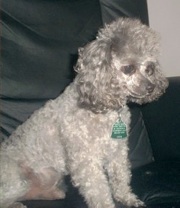
Banded Dutch
This pattern has a waistband and neckband. Use # 15 or #10 on the neck area.
The neck band should end where the neck meets the shoulder. Use a # 5/8, # 7/8or # 8/8 blade on the band.
The band should start at or just behind the last rib. Balance and contour as you scissor the remainder of the coat.
Face, feet and tail are specified. Use # 15 blade
Use a # 15 or # 10 or #9 or # 8 1/2 or # 7 blade on this pattern.
Balance the front and rear sections. The neck band should end where the neck meets the shoulder.
On the front half, follow the back of the shoulder blade to just behind the front leg.
On the rear half, follow around the hip to just in front of the flank. Scissor the rest of the body, balancing and contouring.
The front legs should appear as columns and the rear legs should show angulations.
Be sure the top line is level. Use a # 15 on the face, feet, tail and genital areas.
Neckband placement is from topknot to a point just in front of shoulder, all the way around the neck. On the front of the neck, it is angled like a necklace.
There are four basic Poodle faces. Clean face, Donut Mustache and Beard, Sweetheart Mustache and Beard, and French Mustache.
All of the faces are set the same on the cheek and neck areas.
The muzzle is where the patterns vary. #10 against the grain, unless very sensitive.
Basic Cheek PatternShave a line from the earhole to the corner of eye. The entire cheek area is shaved.
Sensitive FaceThe alternative to shaving is scissoring each of the patterns in.
Poodle Feet#10 for junior and #15 for seniors, against the grain. Hair is completely shaved from the foot.
The wrist bones are used as a guide. You must feel for them on the sides to place correctly.

Brushing
Owning a poodle has the advantage of owning a dog that does not shed hair. This is a boon for many allergy sufferers. However, because the coat does not shed, dead hair must be brushed out otherwise it will mat, which may cause skin problems as air is prevented from reaching the skin. Use a pin brush or a wire slicker depending on the length of hair and type of clip.
Be sure and run the bristles of whatever type of brush you are using over your hand if it is too stiff or sharp don't use it on your dog as their skin can be scratched too.
Your puppy may squirm during the grooming process but must learn to stay still. They will usually come to enjoy their grooming time as a moment when they receive sole attention.
A poodle in a pet clip should be brushed not less than once a week. A show clip needs more frequent brushing. While you are brushing be sure to check on skin condition and for parasites.
Dev, Violet and Rosy
 .
. As you know poodles have non shedding hair which usually grows very rapidly. Therefore grooming on a regular basis is must. A professional groomer every 2 or three months will help keep your dog looking beautiful. Although you can do the regular brushing, a professional groomer will have the dryer and electric clippers and will be able dry the dogs hair after his bath.
Ears
Poodles have floppy ears and hair grows in the ear. The hair must be removed regularly (at least every 3 - 4 weeks) and the ear kept dry or serious ear infection can occur.
The hair in the ear should be carefully plucked out and a medicated ear powder added. Your groomer should do this for you when your dog is clipped.
Check and make sure. You should check the ear weekly a sour smell may be a sign of infection.
 .
. Anal Glands
Located under the dog's tail - should also be cleaned by your groomer when the dog is being bathed.
Ask, to be sure this is being done.
There is very rarely a problem with this in standard poodles, smaller breeds are more prone to problems in this area.
Nail Clipping
Toe nails should also be clipped when your dog is groomed.
If you are clipping the nails at home be sure to have some "Kwick Stop" handy in case you should nip the quick.
If you can hear your dogs toenails clicking on the floor as he walks they are too long.
Bathing and Drying
If you are going to bathe your dog yourself, you should have a telephone shower or spray attachment on your faucet.
Use the same technique you would for checking the temperature for a baby to insure the water is neither too hot or too cold.
Put a rubber non skid matting on the bottom of the tub so that he has good balance and so that he does not scratch the enamel of the tub.
Use a gentle human shampoo (baby shampoo) or a dog shampoo. You can also make up your own shampoo using I liter of Ivory Liquid dish detergent, 4 oz of glycerin, 4 ounces of vinegar.
Mix with water in a one gallon jug. If you have a white dog a drop or two of bluing in the mixture will bring a sparkle to the coat.
If you are going to show your dog then coat care becomes extremely important and this will be covered in some of the specialized books listed at the end of this data sheet.
Start by wetting him thoroughly ensuring that you don't spray water directly into his eyes or ears. Put shampoo on and rub in thoroughly all over rinse well and shampoo again.
Make sure that you rinse thoroughly. If you wish you can add some coat conditioner as you finish the last shampoo.
Rinse thoroughly and then squeeze as much water as you can out of the coat while he is still in the tub.
Wrap him in a bath towel and carry him to the drying table. Do not let him jump in and out of the tub as he may slip and injure himself.
Make sure everything is ready to dry him before you put him into the tub. You will need at least one big bath towel to wrap him in and one for him to lie on.
Keep him covered as you dry him gradually uncovering the areas that you are drying. Do not let the dog jump off the table until he is a well coordinated adult.
This not only helps him to learn not to jump off the table until you are ready to allow it but it also avoids injuries as a puppy may not have the strength and coordination to land properly.
Grooming Table
When you go to the dog groomer you will see the rubber matting covered tables that they use. You can build or purchase one for you own use for his regular grooming.
A table of some sort is recommended as it would be rather hard on your back to groom him properly while he is on the floor.
If you do not wish to have a separate table for this purpose you can convert another table for this use by purchasing an appropriately sized piece of rubber matting which you can place on what ever table surface you chose to use.
The matting will provide good traction for your dog when he is standing on it or jumping on and off the table when he is an adult. The matting will also prevent his nails from scratching the table surface, and will prevent water damage if you happen to be drying him.
. .
